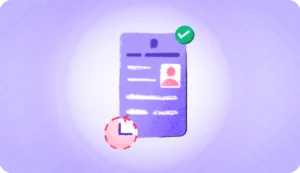I was walking into boardrooms of large companies and explaining the rationale of our APIs by day and going back to our developers to clear technical doubts by the evening.
This post recounts the journey of Adarsh and why you could be a solution architect with HyperVerge.
Finding our feet
The common thought process after entering an engineering college is to get placed in an MNC or pursue higher studies. That was the template I had in mind too, till I joined IIT Madras’s Computer Vision Group in 2012. We spent long evenings and nights building, experimenting, and refining applications that would read hand/eye gestures, automate license plate recognition and reading of OMR sheets, among other things. While our understanding of technology grew, we simultaneously put it to the test against the best universities around the world in international competitions.
Eventually, our learnings and ideas for the future culminated to forming what is known as HyperVerge today. During our formative years, we focussed on building a mobile app that would help people retrieve and share memories with photos.
You are right in thinking that this is very similar to Google Photos, because it was the release of Google Photos that pushed us to reconsider our trajectory. With a few months of runway left, we shifted gears and focussed on B2B sectors such as finance, infrastructure, security and healthcare. We believed that targeting these sectors was a better way to start making a more meaningful impact with AI than building consumer apps.
We walk out into the world
Reinvigorated with this notion we hit the ground running. Until we almost fell flat on our face with our first B2B client in 2017. You see, till then, I was focussed on making the technology work to solve the defined problem. I was training Deep Learning models to meet accuracy standards defined by someone I did not know or meet. I was focused on running ML experiments and wallowing in the weeds of research papers in search of better algorithms, far from the people who’d make actual use of what I was building.
All of that changed when Kedar walked me into the office of a healthcare services company based out of Tamil Nadu in 2017. We had sold the capabilities of AI in automating how their company processed insurance documents. Until then, people would spend more than 40 hours each week to digitise one set of insurance documents. Our prerogative was to automate this process. In our first meeting after the deal had been inked, Kedar and I had openly disagreed and corrected each other in front of the client. Post that meeting, I had realised the difference between coming up with a technical answer to a problem and communicating a solution that worked. Luckily, we managed to save that deal and we built a product that would solve their problem but that was just the beginning. When we went about integrating our solution into their systems, we encountered several challenges – ranging from accommodating the requirements of different teams to integrating with legacy systems. The actual solution always involved sitting with end-users and decision-makers to find a compromise that works.
Crossing the line
Over the next two years, I was involved in bringing the vision of the client to life by learning and implementing scalable architecture and workflow design, end-user experience, compliance, information security and stakeholder management. I was walking into boardrooms of large companies and explaining the rationale of our APIs by day and going back to our developers to clear technical doubts by the evening. Scrum meetings became weekly client calls, discussions over deep learning turned into debates about the best workflows for the client over lunch. I realised that as much as people talk about products and how they fit in the market, I found a lot of joy in engineering the product to fit the people who will use it.
One of the best parts of being an SA is to see and hear about the benefits of AI across stakeholders and time. For example, by helping customers obtain loans instantly, agents could attend to more customer which in turn reduced the operational expenses for large organizations. Over time this translated to lower costs for the end user and afforded agents and others like them the chance to go home early, learn new skills or just be with their family more.
Working as a solution architect offers many moments to see how technology can make a difference. Of all these moments, one of the most memorable came while working with Reliance Jio. The day we had gone live with our AI automated onboarding workflow, we waited to see customers use our technology to sign up for a Jio SIM. The solution had gone live at midnight but by noon we had not seen a single customer sign up until the ticker went up by one and then another, and another. Soon enough our screens had turned into a cascading movement of green pixels as 100’s of thousands of people got their Jio SIM. Of course, we had to experience this for ourselves. Kedar and I walked into a Jio centre and as we went through the sign-up process, there it was, on the top right corner of the onboard screen a line of text saying “Powered by HyperVerge”. By the time we had walked out of the store, Kedar’s SIM card was activated and we had well and truly brought AI to the masses.
Building for the future
In my experience as an SA, I had to break out of my shell as a developer and sit with people who are most affected by what we built and switch between the backend and the frontend of the change that our technology was bringing to people. This has helped me learn how to listen mindfully, find compromises that move projects forward and most importantly learn how to be empathetic with both sides of the product and the market. Even my desktop, once filled with coding terminals looks a whole lot different now.
Today my role has expanded to deploying newer solutions across the globe and this means that we will need a lot more solution architects that will help us find the people-product fit for AI.
If you are someone who has relevant experience in making this happen, reach out to me or come join us here. And even if that is not the case but you believe in what we are building and want to bring complex technological solutions to life, let us know!





